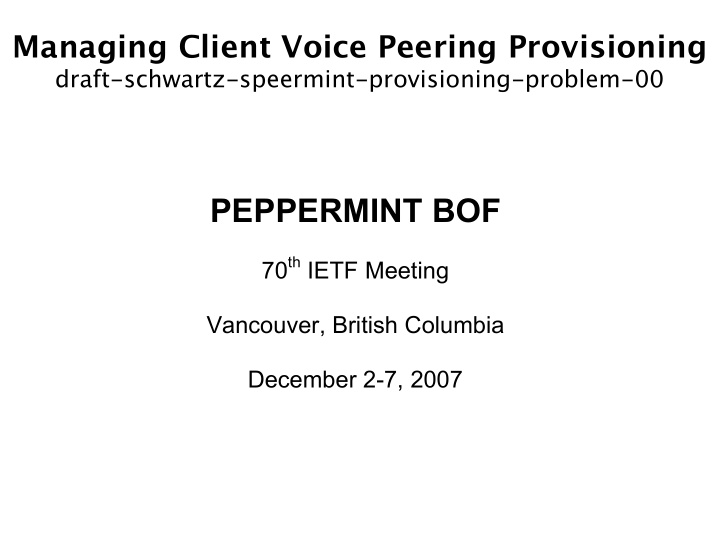



Managing Client Voice Peering Provisioning draft-schwartz-speermint-provisioning-problem-00 PEPPERMINT BOF 70 th IETF Meeting Vancouver, British Columbia December 2-7, 2007
Evolving Peering Relationships
Peppermint Problem Statement It is clear from discussions in both ENUM and SPEERMINT WGs that Multi-Media Interconnection will require various forms of data to be exchanged among administrative domains outside the normal scope of establishing various forms of a SIP session. It’s all about the exchange of data • Who – Ownership, Permission, Authentication, Policy • What – Data Set/Schema, Connotation • Where – Provisioning Interfaces • When – Upload, Synchronization, Real Time • How – Operations, Protocols
The “Who” • Does TN exist anywhere (SPEERMINT LUF)? • Is TN reachable for IP peering (SPEERMINT LF)? o Return “dipped” number and carrier code o New SIP error response code? (“Exists but unroutable”) • Several VSPs may claim some form of responsibility for same TN o Target (“Last Hop”) VSP o VSP that national registry assigned the TN to (“First Hop”) o FH VSP may have no way of knowing if LH VSP included as well • C ommercial registries also contain information used for LNP
The “What” • Organization of registry data is based on TN prefixes o Blocks of phone numbers o Regions / Whole countries • Prefixes… o Global routability o Variable length o Sub/Super prefix – Aggregation • Data Set o Responsibility o Validity o Attributes Type (Unknown, IP, PSTN, both) CC (for prefixes with no IP reachability) Category (free, landline, mobile, pay) Media (voice, video, message) Other? (rate?)
The “Where” Three Provisioning Interfaces
The “When” 1. Upload o As soon as available o Batch (optimal size?) o Throttle / Stagger / Avalanche o Scheduled for times of low query frequency 2. Synchronization o Push / Pull o Master – Slave / Peer o Batch / Scheduling / Throttling / As above… o Delta Vs Full data 3. Data Exchange o “Super” Query o Multiple sources Sequential / Parallel o Local cache
The “How” • Logical operations on registry data o Add – Add (responsible VSP) data about a new prefix to the registry o Delete – Remove prefix as it no longer exists anywhere o Port-Out - Prefix exists but previous owner no longer responsible for it o Port-In – Prefix existed before and is now being assigned to new owner o Transfer – Port-Out followed by Port-in (reduce “failure” time) o Renumber - Prefix changed but associated data remains the same o Modify – Some other attribute of prefix modified (e.g. target URI) • Protocol o AXFR/IXFR o EPP o SOAP/XML o FTP o HTTPS o Other
But, perhaps, the most important question of all is… Why? • Many peering registries are being formed today • Standardization needed before proprietary solutions emerge • Operators are asking for it (use > 1 registry, avoid lock in) • Large consortiums (e.g. GSMA, National LNP/CDB-UK) • Multiple in country (Non LNP) registries • If we wait much longer it will be too late
What Next? • Is there Interest in this work? • Where should it be done? • What previous work can we leverage? • Who wants to help?
Recommend
More recommend